Hubble's beautiful picture of galaxy collisions
NASA has just announced the largest set of images taken by the new Hubble observatory, showing that the galaxies in the universe are constantly colliding and in many strange forms of merger.
Here are some of the 59 pictures of Hubble, revealed on April 24, on the 18th anniversary of the launch of this space observatory.
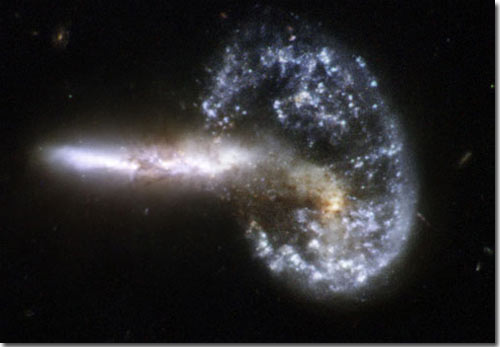
Arp 148 is the result of a clash between two galaxies, creating a ring-shaped galaxy and a long-tail friend. It lies about 500 million light years away from us.
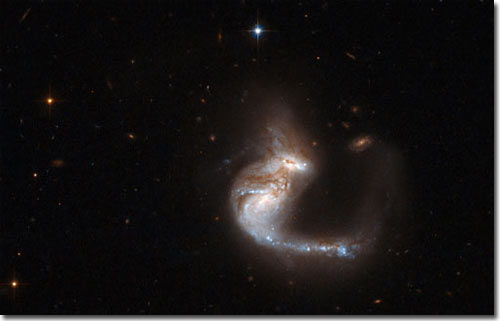
These two galaxies lie 500 million light-years away, in the constellation Lynx, which is considered to be halfway into each other. Their kernels still exist independently, but the two disks overlap.
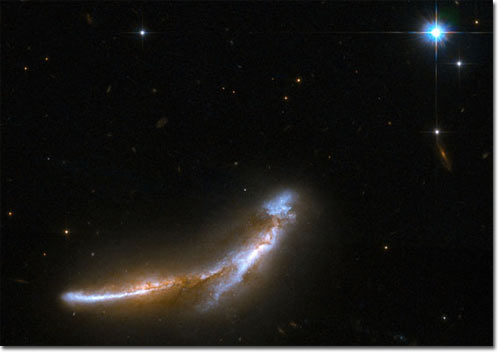
These two galaxies overlap at the edge, emitting infrared light more than a hundred billion times more powerful than our sun.

NGC 6240 is a butterfly-shaped galaxy or shrimp, consisting of two smaller paradises that are intertwined. They are in the constellation Ophiuchus, about 400 million light-years away, and are expected to complete the merger in tens to hundreds of millions of years.
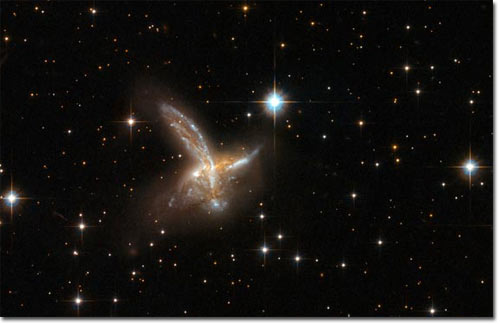
In this picture, a galaxy shaped like chicken feathers is squeezing through the nearby galaxy. They can join together to form a single galaxy. They are located in the constellation Sagittarius, about 650 million light-years away.
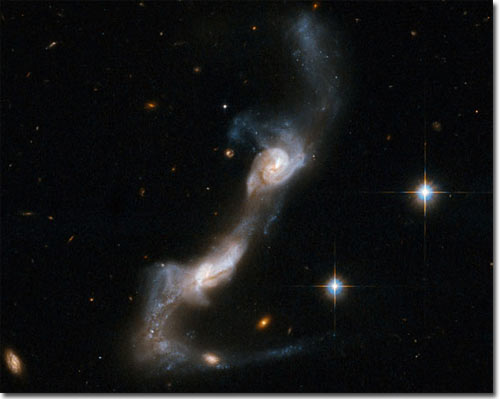
This pair of spiral galaxies looks like two skating athletes wrapped together. This interaction entered the two galaxies together through a material bridge and pulled their curved tail (consisting of gas and stars) out of the " body ". UGC 8335 is about 400 million light-years away.

NGC 17 represents a merger that seems to have been completed. The leftover sign shows that this is a merger that is abundant gas, accompanied by the explosion of stars. It lies about 250 million light-years away, in the Cetus constellation.

Arp 272 is an impressive collision between two twisted galaxies, located in the constellation Hercules. They are connected by twisted arms, located about 450 million light-years away.

The pair of galaxies began to approach each other about 700 million years ago. The interaction between them causes a series of stars to form. The system is located in the Big Bear constellation, about 150 million light-years away.

This clash involves not 2, but 3 galaxies. The trio is 250 million light-years away, in the constellation Peacock.






- The most beautiful images of 2016 taken by Hubble glasses
- Close-up of the Milky Way's twin brothers
- Publish the most complete picture of the galaxy
- The human galaxy will collide with the galaxy M31
- NASA takes a picture of two colliding galaxies
- The galaxy eats each other to grow
- What's special about our Milky Way?
- The magnetic field million light years in the universe
- Milky Way has only 2, not 4 arms
- 1.5 Gigapixel image to Andromeda galaxy with over 100 million stars
- Unexpected information about the galaxy merged after the Big Bang
- The glowing galaxy is 28 million light-years from Earth
 The 11 most unique public toilets in the world
The 11 most unique public toilets in the world Explore the ghost town in Namibia
Explore the ghost town in Namibia Rare historical moments are 'colored', giving us a clearer view of the past
Rare historical moments are 'colored', giving us a clearer view of the past The world famous ghost ship
The world famous ghost ship World's most powerful telescope captures something that threatens to upend cosmology
World's most powerful telescope captures something that threatens to upend cosmology  'Time-traveling assassin' 13 billion years ago kills an entire galaxy
'Time-traveling assassin' 13 billion years ago kills an entire galaxy  The mystery of human lifespan limits
The mystery of human lifespan limits  13 'alien' skulls next to Mayan pyramids
13 'alien' skulls next to Mayan pyramids  How long does it take to reach another star system besides the Solar System?
How long does it take to reach another star system besides the Solar System?  For the first time, 5 super-objects from 13.6 billion years ago have been revealed.
For the first time, 5 super-objects from 13.6 billion years ago have been revealed. 